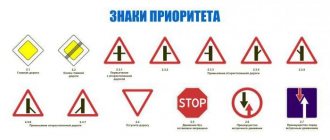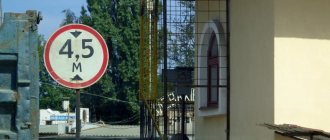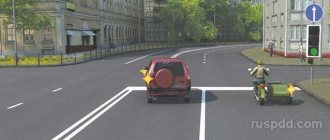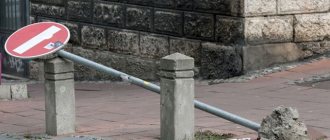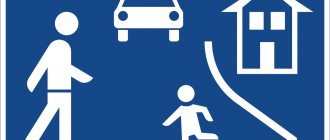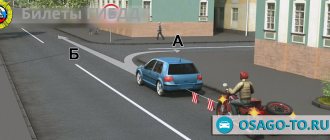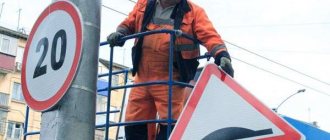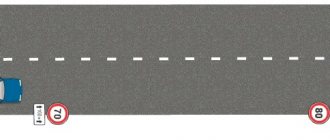Requirements of the sign Intersection of equivalent roads
According to traffic rules, an intersection is the intersection of carriageways of different roads at the same level.
It may be called:
- Adjustable. On it, the order of passage is determined by the light signals of the traffic light or the instructions of the traffic controller.
- Unregulated. You need to navigate by priority signs.
In turn, uncontrolled intersections are divided into equivalent and unequal. Each move has its own characteristics.
If a driver is driving on a road designated as the main road, then the installed sign at the intersection of equivalent roads (1.6) indicates that he does not have the right of way. In this case, the traffic rules regarding obstacles on the right come into effect - that is, you need to yield to those who are on the right hand of the driver. Those approaching from the left are not given priority.
A picture with a detailed description and explanation can be viewed on Internet resources dedicated to traffic rules and preparation for the theoretical part of the exam.
His requirements:
- reduce speed;
- cross the road only by giving way to vehicles approaching from the right (clause 13.11);
- give way to rail vehicles regardless of which direction they are moving from.
If each driver has an obstacle on the right, then the drivers must resolve the situation with the order of passage on their own. To give way in this case, a short switching of the headlights from high to low is sufficient.
In addition, traffic rules regarding the rules for turning, turning and crossing the roadway continue to apply at the intersection.
Signs denoting an equivalent intersection look like a black cross indicating the intersection of roads, enclosed in a triangle with a red border. According to the rules, they are installed within sight of the fork. The distance is 50-100 m in a populated area or 150-300 m on the highway. If sign 1.6 is duplicated by sign 8.1.1, indicating a specific distance in meters, then the distance can be changed upward.
Road sign triangle with a cross inside
Warns the driver when approaching an intersection of equivalent roads.
They are installed in populated areas 50–100 m, outside populated areas 150–300 m before the start of the dangerous area. Can be equipped with a pedestrian crossing. You must give way to any vehicles approaching from the right and to pedestrians. The driver is obliged to reduce speed and assess the situation.
Explanations and comments on the action of the sign:
They are installed in populated areas 50–100 m, outside populated areas 150–300 m before the start of the dangerous area.
Travel rules and fines
According to 13.11, at the intersection of equivalent roads, the driver of a trackless vehicle is obliged to give way to vehicles approaching from the right.
When turning left or making a U-turn, the driver of a trackless vehicle is obliged to give way to vehicles moving on an equivalent road from the opposite direction straight or to the right 13.12.
12.13 part 2 of the Code of Administrative Offenses Failure to comply with the requirement of the Traffic Rules to give way to a vehicle enjoying priority right of passage through intersections - an administrative fine in the amount of 1000 rubles
The sign is a white triangle, wide side down, with a red outline. The sign features a black cross on the diagonal.
An intersection is a place of increased danger for both drivers and pedestrians. After all, traffic flows moving in different directions intersect here, and it is very important to adhere to all the rules related to traffic at the intersection in order to avoid accidents.
Intersecting roads can be of equal or unequal significance. The approach of an intersection with equivalent roads is signaled to the driver by road sign 1.6 “Intersection of equivalent roads , which is a black cross, the crossbars of which are placed diagonally, depicted on a white background and enclosed in a red triangle.
This sign means that roads that intersect are of equal importance, regardless of the road surface.
The first thing a driver must do when he sees such a sign is to slow down, since it is very likely that he will have to give way to vehicles moving on the right. And even if he always drove along the road designated as the main one at previous intersections, still at the intersection in front of which there is a sign 1.6, he will have to give way to cars moving on the right.
Liability for violation of sign 1.6
Sign 1.6 refers to warning types of signs. Responsibility for failure to comply with the restrictions that it establishes will arise in accordance with Article 12.13 of the Code of Administrative Offenses of the Russian Federation.
Sanctions will be applied for:
- Failure to provide the right of way.
- Creating obstacles to traffic (driving onto a roadway filled with parked cars).
If photo and video recording is carried out at an intersection, the driver will be issued an administrative violation report and a fine equal to 1,000 RUB.
In addition, liability may arise under other articles of the Code of Administrative Offenses if the driver:
- will overtake another car at an intersection. For such an offense, financial sanctions are provided (fine 5,000 RUB). Or the use of restrictive measures - the driver’s license will be temporarily suspended. The deprivation will last from 4 to 6 months (part 4 of article 12.15);
- will not turn on the turn signal before performing a maneuver (right or left turn, U-turn, stop). Threatens with a verbal warning or a monetary penalty of 500 RUB (Part 1 of Article 12.14).
All these errors appear due to insufficient theoretical knowledge. And they are not considered a basis for releasing the driver from liability.
Warning signs
Warning signs inform drivers that they are approaching a dangerous section of the road, driving along which requires taking measures appropriate to the situation.
1.1 "Railway crossing with barrier."
1.2 “Railway crossing without a barrier.”
1.3.1 "Single track railway"
1.3.2 "Multi-track railway"
Designation of a railway crossing not equipped with a barrier: 1.3.1 - with one track, 1.3.2 - with two tracks or more.
1.4.1-1.4.6 “Approaching a railway crossing.”
Additional warning about approaching a railway crossing outside of populated areas
1.5 “Intersection with tram line”
1.6 “Intersection of equivalent roads”
1.7 "Roundabout"
1.8 “Traffic light regulation”
An intersection, pedestrian crossing or section of road where traffic is regulated by a traffic light.
1.9 "Drawbridge".
Drawbridge or ferry crossing.
1.10 “Departure to the embankment.”
Departure to the embankment or shore.
1.11.1, 1.11.2 “Dangerous turn.”
Rounding a road with a small radius or with limited visibility: 1.11.1 - to the right, 1.11.2 to the left.
1.12.1, 1.12.2 “Dangerous turns”.
A section of the road with dangerous turns: 11.12.1 - with the first turn to the right, 1.12.2 - with the first turn to the left.
1.13 “Steep descent.”
1.14 “Steep climb.”
1.15 "Slippery road."
A section of road with increased slipperiness of the roadway.
1.16 "Rough Road"
A section of road that has unevenness on the roadway (undulations, potholes, uneven junctions with bridges, etc.).
1.17 “Artificial hump”.
A section of road with artificial hump(s) to force a reduction in speed.
1.18 "Gravel release".
A section of road where gravel, crushed stone and the like can be thrown out from under the wheels of vehicles.
1.19 "Dangerous roadside."
A section of road where pulling off to the side of the road is dangerous.
1.20.1-1.20.3 “Narrowing of the road.”
Tapering on both sides - 1.20.1, on the right - 1.20.2, on the left - 1.20.3.
1.21 “Two-way traffic”.
The beginning of a section of road (roadway) with oncoming traffic.
1.22 “Pedestrian crossing”.
Pedestrian crossing marked with signs 5.19.1, 5.19.2 and (or) markings 1.14.1 and 1.14.2.
1.23 "Children".
A section of road near a children's institution (school, health camp, etc.), on the roadway of which children may appear.
1.24 “Intersection with a bicycle path or bicycle pedestrian path.”
1.25 “Road works”.
1.26 “Cattle Driving.”
1.27 "Wild Animals".
1.28 “Falling Stones.”
A section of road where avalanches, landslides, and falling rocks are possible.
1.29 "Sidewind".
1.30 "Low-flying planes."
1.31 "Tunnel".
A tunnel in which there is no artificial lighting, or a tunnel in which the visibility of the entrance portal is limited.
1.32 "Congestion".
A section of road where there is a traffic jam.
1.33 "Other hazards."
A section of road that contains hazards that are not indicated by other warning signs.
1.34.1, 1.34.2 “Rotation direction”.
Direction of movement on a curved road of small radius with limited visibility. Direction to bypass the road section being repaired.
1.34.3 "Rotation direction".
Driving directions at a T-junction or fork in the road. Directions to bypass the road section being repaired.
1.35 “Intersection section.”
1.35. “Crossroads area.” Designation of the approach to an intersection, the section of which is marked with marking 1.26 and which is prohibited from entering if a traffic jam has formed ahead along the route, which will force the driver to stop, creating an obstacle to the movement of vehicles in the transverse direction, with the exception of turning right or left in the cases established by these Rules. Sign 1.35 is installed at the border of the intersection. If at complex intersections it is impossible to install a road sign at the intersection boundary, it is installed at a distance of no more than 30 meters from the intersection boundary.
Warning signs 1.1, 1.2, 1.5-1.33 outside populated areas are installed at a distance of 150-300 m, in populated areas at a distance of 50-100 m before the start of the dangerous section. If necessary, signs can be installed at a different distance, which in this case is indicated on plate 8.1.1.
Signs 1.13 and 1.14 can be installed without plate 8.1.1 immediately before the start of a descent or ascent, if the descents and ascents follow one another.
Sign 1.25 when carrying out short-term work on the roadway can be installed without sign 8.1.1 at a distance of 10-15 m from the work site.
Sign 1.32 is used as a temporary sign or in signs with a variable image before an intersection, from where it is possible to bypass a section of the road where a traffic jam has formed.
Outside populated areas, signs 1.1, 1.2, 1.9, 1.10, 1.23 and 1.25 are repeated. The second sign is installed at a distance of at least 50 m before the start of the dangerous section. Signs 1.23 and 1.25 are also repeated in populated areas immediately at the beginning of the dangerous section.
Methods of punishment
For ignoring the “Give Way” sign established by the rules, the administrative code provides for a driver’s penalty in the amount of 1,000 rubles. If there is a traffic light on the highway and it operates in green light mode, then this is a priority for motorists. When switching to yellow mode, priority is given to the sign.
Also, while driving, you must make sure that there are no cars with blue flashing lights. They traditionally take precedence over signs. We recommend that you necessarily reduce your speed by shifting to a lower gear or even approaching such intersections slowly. This rule applies to any type of transport, such as trucks, cars or horse-drawn vehicles.
It is important to pay attention to pedestrians who have the right to cross this intersection . They take priority over vehicles moving in any direction. You can often see the sign at signalized intersections.
